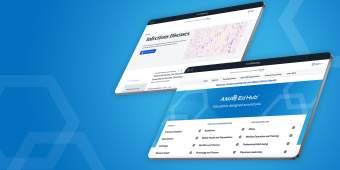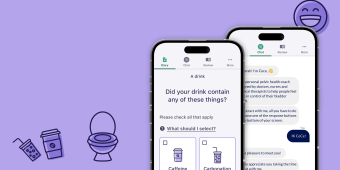Q&A on with Antonio García on design thinking at TXI

In this post, we hear from Antonio García, TXI’s Head of Design, about how design thinking drives the work TXI does and what an organization can expect when they partner with TXI.
Q: Design thinking isn’t a new concept, but its application to software development is relatively rare. What’s going on there?
Not only isn’t design thinking a new concept, it’s one that’s received a lot of attention, to the point of being trendy, almost. There’s been a lot written about its application in consumer packaged goods, consumer electronics, physical products and service models, things like that.
But there isn’t as much discussion of design thinking applied to software and custom software. There are probably many reasons why, but one is likely that the dominant paradigm in software development in the last few decades has been agile, and agile systems aim to produce working code. Agile is very output-focused.
Design thinking is oriented more toward outcomes. So there’s a tension between the two. The thinking is that, if you’re trying to get production code out the door, you don’t have time to conduct user research. You’re pretty sure you know what you need; you just have to build it.
But that mindset gets a lot of organizations into trouble.
Q: What do you mean by “trouble”?
Something like five percent of product innovations succeed. Five percent! That’s terrible. That means 19 out of 20 product innovations fail.
So all the time spent on the development is wasted because the end product didn’t meet the users’ needs or didn’t account for some circumstance. Organizations can be really efficient at producing software, but if their end-users don’t use it, that production is a waste. Building the wrong thing is the most expensive thing you can do.
Q: And design thinking can help?
Design thinking is about finding an intersection between what people desire, what’s technically feasible and what’s commercially viable for the organization. Arguably, the most important thing to figure out is if people actually want or need the thing—it doesn’t matter if you have some proprietary technology or a brilliant business model you think will sustain the innovation. If nobody wants it, neither of those “advantages” matter.
So it's really important to orient yourself to the needs of people, to be human-centered in your approach. When we apply those concepts at TXI, we’re being human-centered in the making of software. And that means we start projects by trying to understand the people who will be using the software we intend to build.
In fact, sometimes our user research leads us to conclude that we don’t actually need to build any software. Sometimes, it shows us that we need to build something really different from what we expected going in—or what our clients expected when they partnered with us.
That’s the whole point of applying design thinking to custom software development. It’s about de-risking the process so we end up with something that actually improves people’s lives or work.
Q: This makes a lot of sense. Why isn’t everyone doing this?
I think a big reason is a lot of organizations are focused on finding the shortest, most cost-effective, most efficient path to THE solution, and most business leaders assume they know what that solution is. And that’s understandable. They’re recruited and compensated for their experience. They’re incented to know all the things.
But there is never just one solution. That’s what you come to understand when you start to operate with a design thinking mindset.
Another thing that keeps people from working like this is that it calls into question their assumptions and organizational orthodoxies. Discovery starts with a lot of questions in order to open up possibility and uncover actionable insights. That inquiry and exploration can be exciting but also uncomfortable, especially when it challenges subject matter expertise or hypotheses about users and competitors. To address this discomfort, we invite our clients to join us in discovery—to see and hear firsthand what people are thinking and doing in real-world contexts. If market fit and user adoption are two of your goals, it's imperative we discuss (and debate!) to align on what we’re learning and how best to act on those insights.
The process of design research and technical discovery is not a self-indulgent boondoggle, but there’s often a rejection of taking time to conduct research and brainstorming when you’re sure you already know exactly what you need built.
To alleviate the guesswork inherent in doing something new, TXI uses a pragmatic, integrated approach to innovation that involves engineers, designers and product folks working in concert to get smart quickly about a domain and engage end users in validating (or challenging) all those hunches and theories. Because if we don’t, the risk of building something no one wants goes way up.
Q: That use of “self-indulgent” is interesting because I think it comes from a misunderstanding of what design thinking is all about.
Right. And one thing that helps a lot of people get over that hump is learning about the six principles to work differently and seeing them in action. Because with the six principles, design thinking becomes much less abstract.
We can point to them and say to our clients: “Here’s how we’re going to approach this problem. We know that if we approach it in this way, we have a pretty good chance of figuring out something really great for you.”
Most people are not used to this. They want to put faith in a genius-type figure, ah-ha breakthrough, or specific process or method. But the reality is when you have really gnarly problems, there is no step-by-step process or tool to solve them. If there was, you’d be using it. You’d have solved the problem already.
And just as important, the collective creativity of a group of people working together and bringing multiple viewpoints and lived experiences to bear is going to yield much better outcomes than any one genius could deliver on their own.
So what we offer is a way of working that consistently leads to innovation.
Q: Is this how you approach all your projects at TXI?
Yes. We’re true believers in this way of working.
But—and this is really important—it’s not because we’re dogmatic or rigid. Our way of working has evolved over 20 years and will likely continue to mature and shift.
We apply design thinking to custom software development and embrace the six principles to work differently because they prioritize outcomes over outputs. They’re more effective and tend to cost less in the long term because they yield right-sized solutions, build conviction, and de-risk and unlock the next wave of effort.
And because they do those things, they enable us to consistently deliver outsized value to our clients. And that’s something other firms cannot always promise.
Published by Antonio Garcia in Product Innovation

Let's shape your insights into experience-led data products together.



